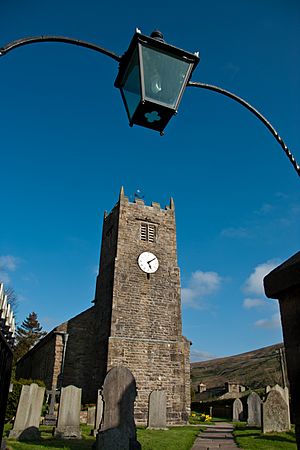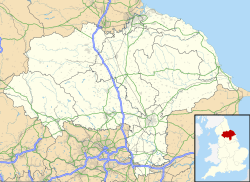Church of St Mary the Virgin, Muker facts for kids
Quick facts for kids Church of St Mary, Muker |
|
|---|---|
| Church of St Mary the Virgin, Muker | |
| St Mary Muker | |

Church of St Mary, Muker
|
|
| 54°22′35″N 2°08′21″W / 54.3763°N 2.1391°W | |
| Location | Muker, North Yorkshire |
| Country | England |
| Denomination | Church of England |
| History | |
| Founded | 1580 |
| Architecture | |
| Functional status | Active |
| Administration | |
| Parish | Swaledale with Arkengarthdale |
| Benefice | Swaledale with Arkengarthdale |
| Deanery | Richmond |
| Archdeaconry | Richmond and Craven |
| Diocese | Leeds |
The Church of St Mary the Virgin is an old church located in the village of Muker. This village is in a beautiful area called Upper Swaledale, in North Yorkshire, England. It is one of four churches in the Parish of Swaledale with Arkengarthdale. The church was built in 1580. Before that, a smaller chapel stood here. This chapel was part of the Church of St Andrew in Grinton. For a long time, people from Muker had to go to Grinton for important events like baptisms, weddings, and funerals. St Mary's Church is special because it was built during the time of Queen Elizabeth I. Not many churches were built then!
A Church for the Community
For many years, people in Muker and nearby villages like Keld had to travel far. If someone passed away, their body had to be carried along a special path called the Corpse Road. This journey was about 10 to 14 miles long to Grinton for burial. It could take up to three days!
In August 1580, the Bishop of Chester, William Chaderton, visited the area. He gave permission for the Muker church to hold its own baptisms, weddings, and funerals. This was a big help for the local people. Even so, the Muker church was still connected to St Andrew's in Grinton. It stayed a "daughter church" for 300 years. Finally, in 1892, St Mary's Church got its own parish. This meant it became fully independent.
The church in Muker became a very important place for religious activities. This happened especially after the chapel in Keld was destroyed. Some old records suggest this destruction might have been linked to a time when many monasteries were closed down.
The Church's Story
The Church of St Mary was built in 1580. This makes it a rare example of a church from the Elizabethan era. Not many new places of worship were built during that time.
When it was first built, the roof was made of thatch. This was changed to slate in 1791. The church tower might have been shorter when it was new. It was made taller in 1719. One person, Glynne, described the tower as "plain" and the windows as "Perpendicular" in style.
The tower is about 7 feet 9 inches by 7 feet 3 inches. The main part of the church, called the nave and chancel, is about 68 feet long and 22 feet wide.
In the 1890s, some old paintings were found under the walls' paint. However, they were not kept. Some older stones, possibly from the 1300s, are part of the church walls. The original bells in the tower might have come from Ellerton Priory. This happened after many monasteries were closed. The bells did not have dates, but their shape suggested they were from the Middle Ages.
The church has beautiful stained glass windows. One window, the east window, shows the local countryside. You can see the River Swale and Straw Beck in it. The church was updated in 1890. During this time, a part called the west gallery was removed. This made the church smaller and some local people were not happy about it. You enter the church through the south door. Above this door, there is a sundial.
Outside the church, about 3 meters south of the porch, there is an old font. It is a special historical item. This font might be the original one from 1580.
Church Family
The Church of St Mary is part of the parish of Swaledale with Arkengarthdale. This group includes four churches. The other three are St Andrew's Grinton, St Mary's, Arkengarthdale, and Holy Trinity at Low Row. In the past, the church was part of the Diocese of Chester. Today, it is part of the Diocese of Leeds.
More to Explore
- Grade II* listed churches in North Yorkshire (district)
- Listed buildings in Muker


